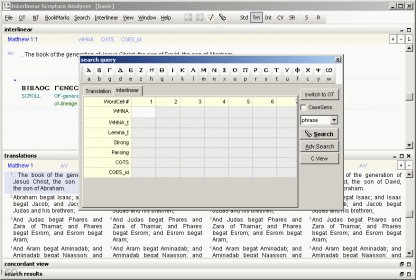

Root (Transliterated) – how to pronounce it with English letters (phonetic pronunciation).Root – the base form of this word, or primary lexical unit.Lemma (Transliterated) – how to pronounce it with English letters (phonetic pronunciation).Lemma – the form of this word which you would find in a dictionary/lexicon.Manuscript (Transliterated) – how to pronounce it with English letters (phonetic pronunciation).Manuscript – the word as it appears in original language texts.The Interlinear row options will vary between RI’s:.Click on an item that you want to show/hide.Right click on the row labels on the left side of the Interlinear pane.(see Turning On/Off the Interlinear pane) Open the Reverse Interlinear pane if necessary.Selecting rows which appear in the Interlinear (ribbon) RI Bibles with Discourse Feature datasets and visual filters are now better to use than Lexham High Definition NT and OT.
Interlinear bible analyzer plus#
For example, “The Lexham High Definition NT: ESV” and “The Lexham High Definition OT: ESV” have original language lemma directly tagged to surface translation, which appears in Right Click plus can be searched. that are not an interlinear nor a reverse interlinear.

Faithlife forum reply about Greek New Testament alignment includes: a reverse interlinear component is added to translations like ESV, NRSV, NASB95, and LXX bibles (where text was translated from Hebrew, whose RI is aligned with Lexham Hebrew Bible). A Reverse Interlinear (RI) bible has original language information aligned with translated text i.e. An Interlinear is an original language Bible with additional information in the form of a grid under the manuscript words e.g lemma, Strong’s number, morphological tagging.What is an Interlinear/Reverse Interlinear Bible?


 0 kommentar(er)
0 kommentar(er)
